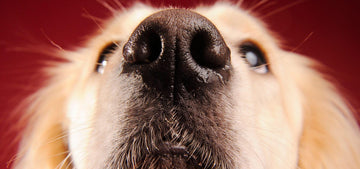
Depending on the breed, dogs can sport an astonishing 100 million or even more scent receptors in their noses. Bloodhounds, those legendary trackers, boast an impressive 300 million!
But why the impressive arsenal? What is it about a dog's world that makes scents so vital? And perhaps the most intriguing question pet owners have: why do dogs sniff butts?
Join us as we uncover the mysteries of this age-old canine behavior and how understanding it can transform our relationships with our four-legged companions.
The Science of Sniffing
Think of a dog's nose as a state-of-the-art sensory device, finely tuned to pick up the faintest of scents. While humans have a respectable 5 to 6 million scent receptors, dogs take the lead, boasting up to 100 million or even more in some breeds.
Each of these scent receptors connects to a specialized part of the dog's brain, the olfactory bulb, which decodes and interprets these signals. This region in a dog's brain is about 40 times larger than that in humans, relative to total brain size.
It's like having a supercomputer dedicated just to smell. This intricate design allows dogs to discern individual components in a scent mixture, much like how we can identify various instruments in a symphony.
The Role of Scent Glands and the Secrets They Hold
Every dog emits a unique scent. While to us, a dog might just have that 'doggy smell', to another dog, this odor contains a wealth of information. The dog odor originates from various glands, especially those located around the rear end.
These scent glands produce pheromones, chemical signals that convey information about the dog's emotions, health, and even its social status.
When dogs engage in butt sniffing, they're not just indulging in a weird habit. They're reading an intricate chemical message, like a status update in the canine world. This behavior helps them understand the social landscape around them and allows them to navigate interactions more effectively.
Jacobson's Organ: The Olfactory's Secret Weapon
Hidden deep within a dog's nasal passage is a remarkable tool that elevates their sniffing prowess: the Jacobson's organ, also known as the vomeronasal organ. This particular organ serves a specialized purpose. It detects not just ordinary scents, but specifically zones in on pheromones-those intricate chemical messages animals exchange.
While the main olfactory system deciphers general smells, the Jacobson's organ interprets these social cues. It's akin to having a dedicated scanner exclusively for social information. This special organ captures a myriad of subtle details, from the mood of another dog to its dietary habits.
But here's another fascinating aspect: the Jacobson's organ plays a role in how dogs process and often ignore certain smells, like poop. To humans, the smell of feces is potent and repelling, a reaction developed for our safety. For dogs, their olfactory system is so refined, and the input of information so vast, that they can filter out what's not currently relevant.
The Jacobson's organ aids in this by helping dogs focus on the essential pheromonal messages and filter out the more mundane or less critical scents. So, while they're aware of the poop's smell, their olfactory system, with the help of the Jacobson's organ, prioritizes the more relevant scents around them, such as the pheromones of other animals.
Why Do Dogs Sniff Butts?
For humans, greetings usually involve handshakes, hugs, or simple hellos. But for dogs, the process is a tad more intimate, especially when it involves butt sniffing. When dogs smell each other, especially in the rear end region, they're diving deep into the intricate world of canine communication.
You see, dogs have an entirely different communication playbook. While they do use barks, growls, and body language, much of their interaction relies on scents.
When two dogs approach and sniff each other, it's not just a matter of curiosity. It's a crucial part of their social interaction. This butt sniffing is as normal for them as our casual chitchats are for us.
They're quickly learning about the other's diet, health, emotions, and even their recent whereabouts.
Gathering Information: A Canine Biography in a Sniff
When dogs get down to the business of butt sniffing, they're collecting a treasure trove of information. Remember, the dog odor that comes from the scent glands carries a detailed profile of that specific dog. It's like reading a biography, but instead of words on a page, the story unfolds in complex chemical notes.
To liken it to human terms, it's as if they are accessing a social media profile of their canine friend, understanding their likes, dislikes, moods, and even recent activities. And it's all considered normal dog behavior.
It's their way of gauging if the new dog is a friend, a potential threat, or just a neutral entity in their environment.
Establishing Dominance or Submission: The Canine Hierarchy
In the dog world, relationships are not just about being friendly. There's an intricate hierarchy at play. Dominant dogs have their unique scent signature, which is easily picked up by other dogs.
When a dog senses this dominant aroma, their reaction can vary based on their own status and temperament. Some may show submission, while others might challenge the dominance, leading to possible conflicts or skirmishes.
Butt sniffing helps avoid many confrontations. By understanding the social rank of the other dog through its scent, a dog can decide how to approach or react to the situation. It's their way of minimizing conflicts and ensuring smoother social interactions.
Nature's Icebreaker: Breaking Barriers and Forming Bonds
Every dog owner has experienced it: a walk in the park turns into a stop-and-sniff fest. It's not just random curiosity; it's an essential part of their social fabric. Dogs use butt sniffing as an icebreaker.
By understanding the background of the other dog, they can approach future interactions with a clearer picture. It breaks down barriers, forms bonds, and even helps in locating potential mates.
Human vs. Canine: Our World of Scent
Let's take a moment to consider our perception of the world. We rely heavily on our sense of sight and sound to navigate our surroundings. For dogs, however, the primary sense guiding their way is their sense of smell.
Comparing the human and canine olfactory systems is like comparing a small garden pond to a vast ocean. Dogs don't just have a more powerful sense of smell; they experience scents in a way we can't even fathom.
Dogs don't just pick up a scent; they can dissect it. When they catch a whiff of something, they're not just identifying a single odor.
They can distinguish the individual components that make up that particular smell. It's like their noses can "read" scents the way we read a page in a book.
But their olfactory prowess doesn't end there. While our sense of smell and taste are separate, for dogs, they're intertwined. This connection, in part, is due to an organ we discussed earlier: Jacobson's organ. It enables dogs to experience scents as if they're both smelling and tasting them at the same time.
When Sniffing Becomes Excessive: Behavioral Aspects
We all know dogs possess a deep-seated instinct to use their noses. The park, the street, or even our living room-each setting offers an array of scents waiting to be investigated. But when does this natural behavior cross a line?
While sniffing is a regular part of a dog's day, continuous or obsessive sniffing can signal that something might be off. There are several reasons why a dog might exhibit this behavior.
Anxiety or Stress
Much like humans, dogs react to stress in various ways. Some dogs might resort to sniffing as a mechanism to cope with their environment or new situations.
Medical Issues
A sudden increase in sniffing can be a symptom of certain medical conditions. Nasal infections or allergies might cause a dog to sniff more than usual. If the behavior seems sudden and out of character, it's always best to consult with a veterinarian.
Seeking Attention
Dogs smelling each other is normal. But if Fido's suddenly sniffing everything and everyone more than usual, he might be trying to tell you something. Perhaps he's craving more attention or maybe there's a specific concern he's trying to alert you to.
Environmental Changes
A new pet in the house, a moved piece of furniture, or even a change in your daily routine can trigger excessive sniffing. Dogs use their noses to familiarize themselves with changes and to establish a sense of security.
Unraveling The Mysteries of Our Furry Friends
So, why do dogs sniff butts? This canine ritual isn't just a quirky pastime-it's a profound interplay of biology, communication, and social cues. As we've discovered, it's more than just an odd habit; it's a vital aspect of their social interactions.
For dog lovers, grasping such intricacies ensures we appreciate our pets in all their natural, instinctive glory. On the topic of nature, when it comes to providing a comforting space for your pup, especially during inclement weather or busy schedules, consider Gotta Go Grass. Check out our range of indoor and outdoor dog potty grass solutions; the natural choice for discerning dog owners everywhere.




